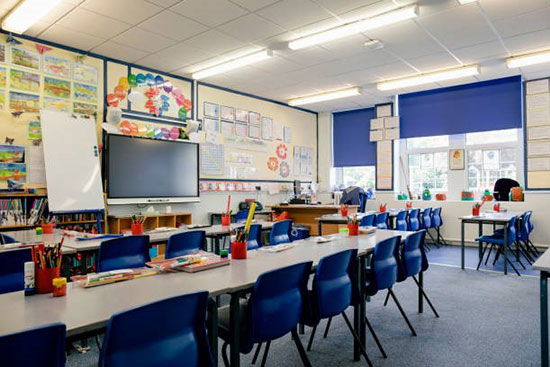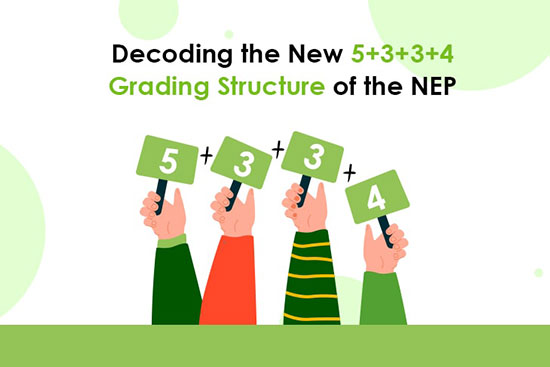A Clear Outline of the 5+3+3+4 Education System New Academic Structure NEP 2020
Get Your Free Trial Now!
New Academic Structure NEP 2020
For the first time ever, the Government of India has replaced the old National Education Policy (NEP) with a new one in 2020, introducing a whole new view of the country's education system. The innovative 5+3+3+4 Education System, the main vitality of this policy, is one of the important education models designed towards developing the whole person and adjusting to the educational transformation.
We will give the main concepts, implications, and potential transforming nature of the 5+3+3+4 Education System New Academic Structure NEP 2020.

Understanding with Education System
The 5+3+3+4 Education System, outlined in the National Education Policy 2020, signifies the restructuring of the existing 10+2 system into four distinct stages: They include foundational (ages 3–8), preparatory (ages 8–11), middle (ages 11–14), and secondary (ages 14–18). Let's delve into each stage to comprehend the nuanced changes: Let’s look into each stage to comprehend the nuanced changes:
 Foundational Stage (Ages 3–8)
Foundational Stage (Ages 3–8)
This is the beginning of the child's education years, when play and doing move the child closer to achieving the goal of the whole education. Cognitive, social, emotional, and creative skills are developed for the kids, and the basis for further academic pursuits is laid within the kids. Stage 5+3 refers here to 5 years of pre-primary education and 3 years of one to three grades.
 Preparatory Stage (Ages 8–11)
Preparatory Stage (Ages 8–11)
The middle elementary years (grades 4–6) will become the preparation stage as per the envisioned plan. This is when the emphasis is on experiential learning, critical thinking, application, and deep understanding of topics. In this stage, 3 years indicates the three years devoted to constructing a sturdy academic base.
 Middle Stage (Ages 11–14)
Middle Stage (Ages 11–14)
Grades 7–9 comprise the middle stage, which teaches multi-disciplinary education. Children are encouraged to study different subjects that will help them discover their interests and talents. This phase is essentially used to show students how to make their academic choice in the course of the subsequent training.
 Secondary Stage (Ages 14–18)
Secondary Stage (Ages 14–18)
The final stage of the process, which includes grades 10–12, provides a solid foundation for the knowledge gained in the previous stages. As the second step, this stage is customized to meet the wide range of interests, career aspirations, and flexibility of students in choosing the subjects. 4 is to represent the dedication of four years to higher secondary study and thus prepare students for further studies or career specialization.
Don’t Miss Out : Digital Transformation in Schools: NEP 2020 Perspectives
The Effects of the 5+3+3+4 Education System
The implementation of the 5+3+3+4 Education System entails several significant implications for students, educators, and the education ecosystem at large:
Holistic Development
This idea of play-based learning is the key that is placed in the beginning stage, which recognizes that a child's holistic development in the formative years is significant. Adopting this approach fosters creativity, critical thinking, and problem-solving skills right from the point of inception.
Reducing Academic Pressure
The novel structure looks to help the students have less academic load by helping them study other subjects in the middle stage. Therefore, learners have a better perception of their strengths and interests, so the transition to tertiary or vocational studies is easier. Flexibility and Choice: The students are given the flexibility to select subjects of their interest and career goal at the secondary stage, which the 5 + 3 + 3 + 4 set-up advocates for. The flexibility feature elevates the value of education, which is most responsive to the many skills and ambitions of youth.
Teacher Training and Professional Development
The implementation of this system is done in an effective way through the role of the educator. The NEP 2020 points out those teachers need to be trained and must receive knowledge updates since pedagogical approaches and methodologies are always evolving.
Integration of Technology
The policy aims at the integration of technology in the education process of teaching and learning. This was also done not only to ease the accessibility of education but also to equip students for the digital era, which synchronized with the worldwide trend toward technology-immersed societies.
Global Competitiveness
The new system creates the much-needed early exposures to critical thinking, creativity, and problem solving, which are the attributes needed for global competitiveness. This, in a way, propels India into a well-established knowledge economy around the world.
Inclusive Education
Aligning with early childhood education, the program demonstrates an inclusive approach to different learning styles to provide every child with a quality education regardless of socioeconomic background. The system works towards filling the existing gaps in access to education through a comprehensive gap analysis and emphasizes the principles of inclusivity and individual empowerment.
Aligning Education with Industry Needs
Through the secondary stage, the students have a chance to make their idea of education fit the changing needs of different industries. This in turn also bridges the divide between theoretical learning and adequacy for practical industry needs.
Promoting Research and Innovation
The multidisciplinary approach of the middle stage can be a way for students to experiment in different fields; thus, a culture of research and innovation is embraced. Such kinds of developments create the foundations of a knowledge-based society and economy.
Read Also : Implementing AI in Schools: A Guide for Effective Assignments
Conclusions about 5+3+3+4 Education System New Academic Structure NEP 2020
The inclusion of the 5+3+3+4 educational framework within the National Education Policy 2020 is a culmination point for the Indian education system. This novel design, which is based on the concepts of overall ability enhancement, reduced stress, flexibility, and technological integration, could recreate the future of education in India. The country will undertake a transformative process as it shifts its educational system.
The successful execution of the initiative is crucial, and the government should engage in continuous monitoring and adjustments to fit the changing needs of the learners and society. The 5+3+3+4 education system is not just about numerical representation; it is about a plan that will foster the minds that will define the future of the nation. This was all about 5+3+3+4 Education System New Academic Structure NEP 2020.

FAQs about 5+3+3+4 Education System New Academic Structure NEP 2020
Why is personalization and choice a key at the secondary stage?
The secondary school (age 14–18) stage offers flexibility to students by allowing them to choose subjects based on their interests and career goals. Such adaptively guarantees that education continues to be responsive to the versatile talents and dreams of youth.
What does the NEP 2020 say regarding the uplifting and training of teachers?
Under the NEP 2020, continuous training of teachers is recommended for them to acquire the latest attitudes and methods of instruction. This ends up ensuring that the teachers are well prepared to ensure efficiency in implementing the new system.